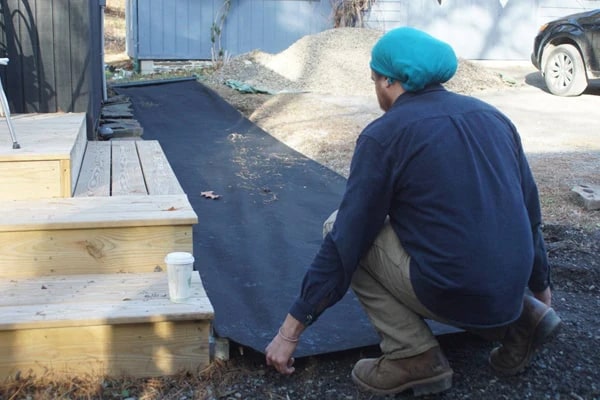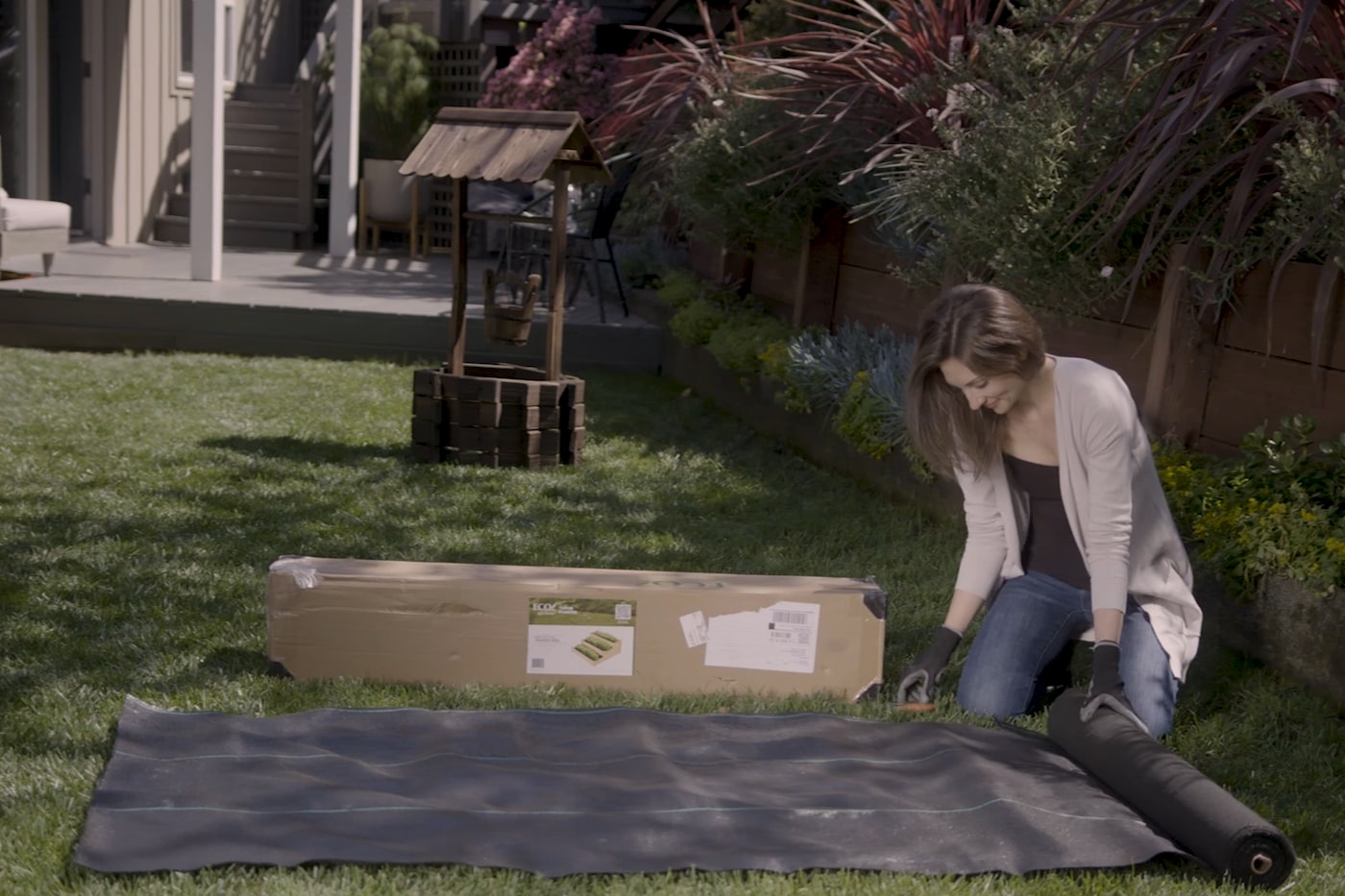Weeds – they compete with your precious crops and multiply so quickly, it only takes a few weeks before they overwhelm the garden.
Pulling weeds by hand is one way to remove weeds; it’s a backbreaking, time-consuming job. Not a lot of people can spend their weekends pulling weeds.
To control weeds in big gardens with less effort, try using landscape fabric. Installation is quick, and it does the job for months, even years. In this guide, let’s find out if using landscape fabric for weed control is right for your garden.
Contents []
Does Landscape Fabric Work to Prevent Weeds?

Landscape fabric is like a barrier installed over the soil to try and stop weeds from growing. The material, which is usually made of a woven fabric, blocks sunlight weeds need to grow, just like plants. So, by blocking the sunlight, the fabric stops weeds from sprouting up.
But does it really work? When it comes to suppressing weeds, landscape fabric is quite effective. It can make your garden look neater and save you some time pulling weeds. Plus, it can help conserve water by preventing evaporation from the soil.
However, landscape fabric isn’t perfect. Some weeds are pretty tough and can still push through the fabric or find ways around it. Plus, over time, bits of soil and organic matter can build up on top of the fabric, creating a perfect spot for new weeds to grow. So, while it might work for a while, you might still have to do some weeding down the road. But, you won’t work as hard to remove some weeds, if ever some manage to grow, thanks to the landscape fabric.
So, should you use landscape fabric? It really depends on your situation. If you have a big weed problem and don’t mind the extra maintenance down the road, it might be worth trying. Just keep in mind that it’s not a miracle solution, and you might still have to do some weeding.
If you’re worried about the environmental impact, you might want to look for landscape fabrics made from recycled or eco-friendly materials.
When Is It Okay to Use Landscape Fabric?
Using landscape fabric in gardening or agricultural applications can be advantageous in various situations:
If weeds keep coming back: Landscape fabric serves as an effective barrier against weeds, reducing competition for nutrients, water, and sunlight. This is particularly useful in garden beds where weed growth can hinder the growth of desired plants.
To retain soil moisture and temperature: By preventing evaporation from the soil surface, landscape fabric helps retain moisture, reducing the frequency of watering needed for plants. This is beneficial in both gardens and agricultural fields, especially in regions with limited water resources.
Landscape fabric can also moderate soil temperatures by insulating the soil from extreme heat or cold. This creates a more favorable environment for plant growth, particularly in regions with fluctuating temperatures.
To prevent soil erosion in gardens: In agricultural crop rotation systems, landscape fabric can be used to cover fallow fields, suppressing weed growth and preventing soil erosion while allowing the soil to rest and regenerate nutrients for future crops.
In sloped areas or regions prone to erosion, landscape fabric helps stabilize the soil, preventing erosion caused by rainfall or irrigation. This is crucial for maintaining soil health and preventing nutrient runoff.
Installing landscape fabric on gardens will loose soils and will also help prevent soil erosion. The material works like a barrier that will prevent soil particles from being washed off.
For pest control: In agricultural settings, landscape fabric can serve as a protective barrier against pests such as root maggots or nematodes. It can also protect the plant roots from nibbling insects. By blocking access to the soil, it reduces the risk of pest infestations and minimizes the need for chemical pesticides.
To make mulch last longer: When used in conjunction with mulch, landscape fabric helps hold the mulch in place, preventing it from being displaced by wind or water erosion. This ensures consistent mulch coverage, which aids in weed suppression and moisture retention.
To extend the growth season: In colder climates, landscape fabric can be used to cover garden beds in early spring, creating a warmer microclimate that enables earlier planting and extends the growing season for certain crops.
To boost productivity and quality: By creating a weed-free, moisture-retentive environment, landscape fabric promotes healthier plant growth and development. This is particularly beneficial for crops, ornamental plants, and fruit trees, leading to higher yields and improved overall plant health.
Because landscape fabric reduces the need for frequent weeding, watering, and soil maintenance, saving time and labor for gardeners and farmers. This allows for more efficient use of resources and increased productivity regardless if you are growing your own food or for profit.
How to Know If Landscape Fabric Can Work for You

Should you install landscape fabric in your garden? The answer will depend on how extensive the weed problem is in your garden. Other factors worth considering include the soil health of the garden, the kinds of plants you plan to grow, and if you can keep up with the maintenance.
How extensive is the weed problem?
Before installing landscape fabric, you need to check the severity of weed growth in your garden. If you find yourself spending a lot of time pulling weeds or struggling to keep them under control, landscape fabric might be beneficial. It can help reduce weed growth and minimize the need for frequent weeding.
But if your garden is only a tiny slice of space and there are only a few weeds growing, you might not need landscape fabric. You’re better off using a hoe or trowel to remove weeds manually.
Consider your garden layout
Landscape fabric might not work for some garden designs.
Think about the layout of your garden and where you plan to install landscape fabric. It’s most effective in areas with established garden beds or under hardscape surfaces like paths or driveways. If you have sloped areas prone to erosion or areas with persistent weed problems, landscape fabric could be a good option.
Check the soil conditions in your garden
Landscape fabric works best in well-draining soils where water can penetrate easily.
If you have heavy clay soil or poorly drained areas, landscape fabric may not be as effective and could lead to waterlogging or soil compaction.
Heavy clay soil has tiny particles that are closely packed together, leaving little space for water to infiltrate or drain away. When landscape fabric is installed over this type of soil, any water that does manage to penetrate the fabric may become trapped, leading to waterlogging.
When landscape fabric is placed over compacted soil, it can exacerbate this problem by preventing natural processes like earthworm activity and root penetration, which help to loosen and aerate the soil.
Over time, the weight and pressure of the fabric, as well as any foot traffic or heavy rainfall, can further compact the soil, making it difficult for plants to establish healthy root systems and access essential nutrients and moisture.
What plants do you want to grow in your garden?
Being mindful of your planting plans ensures that landscape fabric integrates seamlessly into your garden design while accommodating existing plants, future plantings, crop rotations, and changes in garden layout.
Some landscape fabrics have pre-cut holes or slits to accommodate existing plants and future plantings; others do not. If you frequently rotate crops or change your garden layout, landscape fabric may require more maintenance and adjustments.
If you frequently change the layout of your garden or experiment with different designs, landscape fabric may not be the most flexible option. Since landscape fabric is typically installed for long-term weed control, altering the layout of your garden beds can require removing and reinstalling the fabric, which can be labor-intensive and time-consuming.
Keeping up with the maintenance
Think about your maintenance preferences and how much time and effort you’re willing to invest in your garden. Landscape fabric can reduce the need for weeding and watering, but it also requires occasional maintenance, such as checking for weed growth and replenishing mulch. There are upfront costs associated with purchasing fabric and materials for installation.
Also worth considering is the cost of maintaining the landscape fabric. By reducing the need for weed control measures and conserving water, using landscape fabric can be a cost-effective solution in the long run.
Also, don’t forget to take climate and weather conditions into account when maintaining the garden.
Landscape fabric is most effective in areas with mild to moderate climates where it can provide consistent weed control and moisture retention. In extreme climates with heavy rainfall or prolonged periods of drought, landscape fabric may require frequent monitoring and maintenance.
ECOgardener Landscape Fabric For Your Garden

If you’re looking for a low-maintenance solution for weed control and soil protection, landscape fabric may be a good fit. But, if you’re unsure whether landscape fabric is best for your garden, consider consulting with gardening experts or professionals. They can provide personalized advice based on your specific garden conditions and help you make an informed decision.



